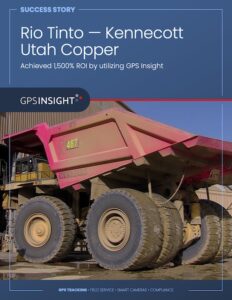What is Asset Tracking?
Four Benefits to Better Manage Your Mixed Fleet
Have you ever had to keep track of many pieces of equipment over a large jobsite? Have you ever thought, “Is my trailer still where I parked it?” or “What happened to that backhoe?” If you’ve managed a fleet of yellow iron, snow plows, containers, or trailers, you know how tricky it can be to know where everything is all at once—and ensure you’re using all your assets and equipment effectively.
Efficient asset management is mission critical for mixed fleets—especially for a construction business, a utilities company, or a public sector fleet. Even landscaping and farming fleets can benefit from an asset tracking system. Whether it’s knowing the location of all your physical assets, managing maintenance schedules, or preventing downtime, businesses need workable solutions to effectively monitor—and control—their valuable resources.
This is where the GPS Insight asset tracking technology comes into play. In this blog, we’ll run through the top four features and benefits of having a GPS asset tracking system to manage your mixed fleet.
1. Know your assets’ locations at all times.
Okay, so this one might be a little obvious, but the benefits can’t be understated. If you have a few vehicles and an extra piece of equipment here and there, keeping track of your assets might be a breeze for you. But if your jobsite is, say, 25 miles wide, you’re probably going to have trouble identifying the location of your equipment without some kind of asset tracking system.
Asset tracking from GPS Insight provides real-time visibility into an asset’s location, ensuring that you always have an up-to-date understanding of your assets’ whereabouts. If that asset moves on or from the jobsite, no problem – you can track its location with pinpoint accuracy.
 | Customer story: Kennecott Utah Copper had a large fleet of vehicles and equipment over a large job site. They also had high fuel usage and long idle times that were costing them lots of money. Implementing a GPS Insight’s asset tracking solution helped them better manage their fleet and save 1 million dollars in fuel costs over the course of a year. Learn more here. |
2. Prevent theft and completely eliminate unauthorized use.
There are plenty of ways to keep equipment protected when it’s at the jobsite. But you can’t always ensure the equipment will stay in place once it’s there. And unfortunately, moonlighting and side jobs aren’t terribly uncommon.
Asset tracking software typically offers geofencing functionality, which allows businesses to create virtual boundaries or geofences around specific locations. Whenever an asset equipped with GPS tracking devices enters or exits these boundaries, the system will trigger a notification through the software. With this feature, fleet managers can monitor their vehicles’ movements and ensure that they are being used in compliance with predefined routes and schedules.
This improves asset visibility and reduces the risk of asset loss or theft, ultimately protecting the bottom line. By having real-time information about the location and condition of assets and equipment, businesses can also optimize asset utilization and make informed decisions regarding deployment and maintenance.
3. Say goodbye to unplanned maintenance and repair issues.
It’s hard to keep track of everything…but with GPS Insight, you don’t have to do it alone.
Paired with GPS Insight hardware, our asset tracking software gives you a maintenance log that tracks everything you need to know. Long before a check-engine light turns on, you’ll get a notification of a potential mechanical issue.
We can take it from here…let the asset tracking software tell you when an oil change is due. And don’t forget about tires! Our tire rotation reminders will let you know when you need to take your equipment in, which extends the life of your tires. We all know regular oil changes keep vehicles running smoothly, so our system will alert you to stay on schedule. Plus, with milage-based alerts, you’ll keep up with all the recommended tune ups for your fleet.
The GPS Insight asset tracking makes sure nothing falls through the cracks. It’s just another way that software makes your life easier…and your fleet better.
4. Get an ROI you can measure.
Get an asset tracking system that pays for itself.
When you reduce your monthly fuel, repair, and insurance bills, you easily regain the dollars you’ve spent. With asset management, you can cut costs across the board when you keep drivers from speeding, idling, or making unnecessary stops. You’ll know how much you’re spending – and if you’re spending for the right reasons.
One of the areas you’ll immediately see results is with fuel. You’ll get reports on who is idling, when, and for how long. If you have tracking in vehicles, you’ll see what drivers are speeding up too quickly. You’ll see if anyone is making stops that could be more efficient. All this data will quickly help you benefit from fuel savings.
Fuel will be saved…and time will be saved. With asset tracking, drivers can easily see how they can be more efficient.
A purchase that immediately improves your bottom line is an easy choice.
Reap All the Benefits of Asset Tracking
We hope the features and benefits we shared above got your wheels turning. But truth is, we’re just getting started. See the full list of benefits below!
- Enhanced asset visibility: The GPS Insight equipment and asset tracking system provides real-time information about the location and condition of assets, ensuring fleet managers and business owners have complete visibility into their assets’ whereabouts.
- Improved inventory management: By automating asset tracking processes, you can streamline inventory management, reduce manual errors, and easily generate accurate reports.
- Proactive maintenance management: Our asset tracking system enables businesses like yours to create maintenance schedules, automate work orders, and receive notifications when assets require attention. This allows for proactive maintenance, which helps you minimize costly downtime.
- Increased operational efficiency: By eliminating manual and time-consuming asset tracking tasks, you can improve overall operational efficiency and allocate resources more effectively.
- Theft and loss prevention: The GPS Insight asset tracking system helps mitigate the risk of asset loss or theft by providing real-time monitoring and alerts whenever assets leave predefined boundaries.
- Optimal asset utilization: With accurate asset location information, businesses can optimize asset deployment, ensure assets are in the right place at the right time, and avoid unnecessary asset purchases.
- Cost savings: By preventing downtime, reducing manual labor, and optimizing asset utilization, you can see significant cost savings and improve your bottom line.
- Streamlined audits and compliance: Automated asset tracking software simplifies audits, ensuring your business remains compliant with regulatory requirements.
- Seamless integration: The GPS Insight asset tracking system can seamlessly integrate with other software solutions. This allows for centralized access to your asset and equipment information and helps you collaborate effectively across all departments.
- Cloud-based accessibility: When asset information is stored in the cloud, you’ll be able to access critical data from anywhere and at any time.
- Industry-specific advantages: The GPS Insight asset tracking system offers tailored features and functionalities for specific industries, addressing unique industry challenges and requirements.
With the GPS Insight equipment and asset tracking system, you’ll be more organized, reduce costs, and ultimately, improve your business.
Want more?
Get a Price Quote
Ready to see how GPS Insight fleet and field technology can work for you?





